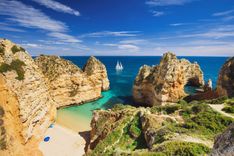12. Ilha Deserta
Ilha Deserta is part of the Ria Formosa Natural Park and really lives up to its name—there are no permanent residents, no roads, and very little development. It’s only accessible by boat, usually from Faro, and makes a good day trip if you’re looking for some quiet time in nature.
The island has the longest stretch of undeveloped beach in the Algarve—about 4.3 miles (7 kilometers)—and it’s great for a long walk or swim. You’ll also find Portugal’s southernmost point here. There’s a raised wooden path that cuts across the island, which helps protect the dune system.
Aside from the boardwalk and the beach (one of the best beaches in Portugal), there’s just one restaurant, Estaminé, which focuses on seafood and sustainability. It’s the only place to buy food or drinks, so bring water and whatever else you’ll need for the day. Ferries and water taxis usually run more frequently in summer, but it’s a quiet escape year-round if the weather holds up (see more about the weather in our guide to the best time to go to Faro). This is what to do in Faro to get out in nature.
Within the Ria Formosa lagoon, there’s a network of small, family-run oyster farms that use traditional methods to raise oysters in tidal beds. These farms are usually reached by boat from towns like Faro or Olhão, and most tours are guided by someone who works directly with the oysters.
You’ll ride through the shallow channels by small boat, stopping to see how oysters are grown in mesh baskets and how the tides and water quality affect their growth. It’s a low-impact process that’s been refined over generations, and most tours explain both the environmental and economic side of it.
Most visits end with a tasting—fresh oysters opened on the spot, often served with vinho verde or sparkling wine. Depending on the tide, you might have the tasting on a sandbar, a dock, or right on the boat. Without a doubt, this is one of the best things to do in Faro.
Planning a trip to Portugal? Don't miss our guide to the best things to do in Lisbon.













